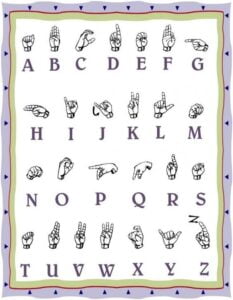American Sign Language (ASL) is a vibrant and expressive visual language used by the Deaf community in the United States and parts of Canada. What sets ASL apart is not just its use of gestures but also its unique grammar, which differs significantly from English grammar. Understanding ASL grammar unveils the intricacies of this fascinating language and the benefits it offers in communication and expression.
The Essence of ASL Grammar: Visual and Spatial Expression
ASL grammar relies heavily on visual and spatial elements, using handshapes, movements, and facial expressions to convey meaning and structure sentences. Unlike English, which uses word order and tense to signify meaning, ASL relies on spatial relationships, non-manual markers, and classifiers.
Differences from English Grammar: Syntax and Structure
One of the prominent differences between ASL and English grammar lies in their syntax. English typically follows a Subject-Verb-Object (SVO) order, while ASL employs a Topic-Comment structure. In ASL, the topic of a sentence is introduced first, followed by the comment or additional information.
Moreover, ASL utilizes facial expressions, head movements, and body language as grammatical markers. These non-manual markers play a crucial role in indicating questions, negations, conditionals, and emotions, adding depth and context to the conversation.
Benefits of ASL Grammar: Visual Clarity and Expression
The unique grammar of ASL offers several advantages in communication. Its visual nature allows for clarity and precision in conveying concepts and emotions. ASL users can express complex ideas using spatial relationships and classifiers, enhancing the depth of communication.
ASL grammar’s flexibility allows for creative expression and storytelling. Signers can manipulate space, movement, and facial expressions to illustrate narratives vividly, adding layers of meaning and emotion that might be challenging to convey in spoken languages.
Embracing ASL Grammar: Cultivating Inclusivity and Understanding
Learning ASL grammar goes beyond mastering gestures; it involves embracing a linguistic structure that embodies the culture and identity of the Deaf community. Understanding and appreciating ASL grammar fosters inclusivity, enabling individuals to engage more authentically with the Deaf community.
Moreover, incorporating ASL grammar in communication breaks down barriers, promoting accessibility and understanding among diverse communities. It encourages a deeper appreciation for the richness and diversity of human languages and communication methods.
Conclusion: ASL Grammar as a Unique Linguistic Tapestry
ASL grammar is a testament to the diversity and depth of human language. Its visual and spatial nature, distinct from English grammar, provides a unique framework for communication, emphasizing expression and clarity.
By acknowledging and understanding ASL grammar, individuals not only gain proficiency in a fascinating language but also embrace inclusivity and cultural understanding. ASL’s grammar structure enriches communication, offering a new perspective on expression and fostering connections within diverse communities.
As we delve into the intricacies of ASL grammar, we embark on a journey that celebrates the beauty of linguistic diversity and cultivates empathy, understanding, and inclusivity in our interactions with the Deaf community.



